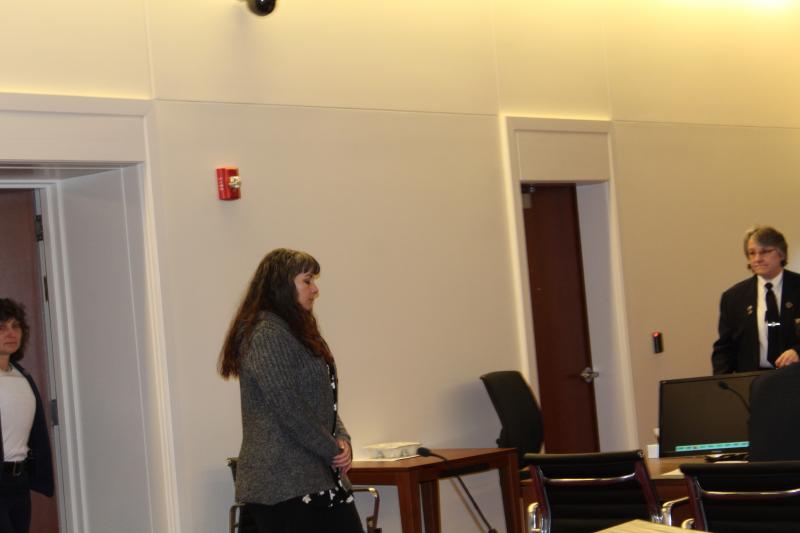Testimony continues in murder trial in Wiscasset girl’s death
On the second day of the Kendall Chick murder trial Tuesday, Maine Chief Medical Officer Mark Flomenbaum testified that the cause of the 4-year-old Wiscasset girl’s death was blunt force trauma to the abdomen, which caused acute peritonitis due to a tear in the peritoneal cavity wall. This led to a swift infection, he said. Shawna Gatto is charged with murder.
Chick’s pancreas and bile ducts were also affected, leading to blood and a mixture of brownish liquid that distended Chick’s abdomen, and gas filled the abdominal cavity, Flaumenbaum said. “(At) some point, the heart simply didn’t have enough blood to pump, and stopped.”
Prior to that, however, the heart was unable to carry enough oxygen to Chick’s brain, which started to swell, Flomenbaum said. “It was an early sign of dying during a slow dying process.”
In Flomenbaum’s opinion in an addendum to his autopsy report, death would have followed between one and 12 hours after the injury, which had no external signs. Flomenbaum said the injury could have been caused by squeezing the child. He was relatively certain the death was caused by abuse, rather than a fall, mostly because Chick’s slight body would not have had the momentum to cause the injury, even in a fall against a table or down a flight of stairs.
Based on the patterns of bruising, Flomenbaum said Chick suffered from child abuse syndrome.
“Do bruises continue to change after death,” asked Assistant Attorney General John Alsop.
“No, death stops the clock,” Flomenbaum replied.
That was not the case with the abdominal injuries, he said. He said he was reasonably certain about the one to 12 hour window for that injury because of the flora in the affected tissues, and said he believed the actual time was closer to three to six hours from injury to death, in part because the majority of the responding white blood cells are the first cells to converge on the infection. “If it had been much later, it would have been leukocytes or macrophages, which colonize an infection later in the process,” Flomenbaum said.
Under cross examination, defense attorney Jeremy Pratt tried to open up the range. He asked if 12 hours and 15 minutes wouldn’t be possible. “Anything is possible, but the most probable range is three to six hours,” Flomenbaum said.
Pratt asked Flomenbaum if he had read Dr. John Spencer Daniel’s report. Daniel was a defense witness hired by Pratt and Cohen.
“No,” Flomenbaum said. “I was given his PowerPoint presentation.”
Flomenbaum said the thymus, a gland that aids infants and young children with their immune systems, had changed shape in Chick. That was likely a response to stress, he said. Changes to cells in the heart were also stress indicators, he said. Flomenbaum said Chick’s hair loss is also stress related. He declined to identify what Chick’s stress response was to, but said all three conditions were common in children who had suffered from child abuse syndrome.
Among his major findings were the child abuse syndrome, a constellation of physical conditions and injuries, which while not fatal in and of themselves, contributed to the final outcome. There were 15 to 20 distinct injuries to Chick’s head and face; he also demonstrated parallel lines on her face consistent with the fingers and fingernails of a human adult hand. Her head had a healed scar under the skin which had originally been mistaken for a skull fracture, and a great deal of blood under the skin on the right side of her head. Her right ear bore an injury consistent with tweaking the ear, possibly being carried by the ear.
The marked expansion of the abdomen, however, originally been thought to be air pumped in accidentally through the esophagus during the attempt to resuscitate the child, was too great to be explained that way, he said.
Justice William Stokes asked about the distinctions of the three types of white blood cells, and the distinctions between abrasions, lacerations and contusions. Flomenbaum said abrasions were skin deep scratches, such as might be experienced by any toddler who falls. Lacerations are deeper open wounds, and contusions are closed skin bruises. Chick had numerous instances of each type of injury, he said.
The defense had asked to present its expert witness immediately after the medical examiner. Daniel agreed with most of Flomenbaum’s conclusions, including that Chick was an abused child, but said he believed he could see small veins beginning to reform in some of the microscopic slides of the pancreas, putting that event prior to when Flomenbaum believed. Daniel said the pancreas injury could have occurred as early as 72 hours before death.
Recalled to the stand, Flomenbaum said he believed the veins Daniel saw were dilated veins caused by the white blood cells that had converged on the injury. Both pathologists suggested Chick might have been dead for several hours before 9-1-1 was called, based on the physical evidence.
The trial is set to continue Wednesday.
Event Date
Address
United States
























